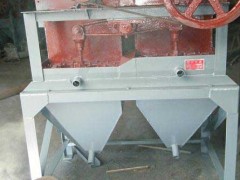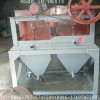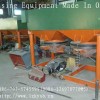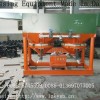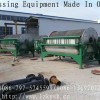JT、Gravity Jig
Ore dressing by Gravity Jig is considered as one of the major means for gravity beneficiation with the process characteristics being continued feed of ores to be beneficiated onto screen plate in Jigging Chamber, forming thick material layer. Upward flow is injected via screen plate periodically, allowing the lift of bed layer to be loose and flow to drop(or stop rising ).During this process, grains of different densities will displace relatively, with the heavy materials bring delivered into lower layer and the light material being transferred into the upper layer. Concentrate and tailings will be obtained after their being discharged respectively.
Sawtooth-wave Jig is a new type of energy conservation and highly efficient gravity separation equipment and developed based on the traditional Sine Wave Jig. The difference between Sawtooth .Wave Jig and Sine Wave Jig is that the pulsation curve for jigging is of sawtooth wave shape, with speedy upward flow and slow downward flow. Bed layer is elevated integrally and slowly dropped with a long effective loose time, allowing significant increase of handling capacity for unit serene surface, decrease of lower limit of grain size recovery and large save of make-up water for undersize fraction. Industrial tests carried out of Sawtooth Wave Jig and Sine Wave Jig for comparison showed that the recovery rate for operation of Sawtooth Wave Jig is raised by Sn:3.01%,Pb:1.63%,Xn:2.04% with water consumption being decreased by 30-75%.
Ore dressing by Sawtooth Wave Jig is capable of handling almost full sizes of mineral materials other than very fine material. It features simple process operation, heavy duty equipment handling capacity with final products being obtained through one time separation. Therefore, it has found a wide application in production. It is regarded as one of major means to cope with metallic ores such as iron and manganese ores of coarse, moderate and fine sizes and has found significant use in beneficiating tin and tungsten ores. Moreover, Jigging Method also can achieve a good result in processing primary ores bearing gold, tantalum niobium, titanium, zirconium and chrome and sand stones.
More density minerals to be separated in ores have, wider range the feed sizes have. For gold bearing placer, when feed grain size is less than 25 mm, separation may be carried out without size classification with the lower limit of recovery up to 0.05 mm. For ordinary metallic ores, size classified separation is conducted to effectively improve indexes for separation and to enhance handling capability for the equipment.
|
Model
|
Area
|
Stroke
|
Times of stroke
|
Feed
Size
|
Capacity
|
water
|
Power
|
Overall dimensions
|
Weight
|
|
㎡
|
mm
|
r/min
|
mm
|
t/h
|
m3/h
|
kw
|
mm
|
t
|
|
|
JT2-2
|
2.28
|
12-17
|
80-180
|
<10
|
4-8
|
1-3
|
2
|
3220/1550/2050
|
1.6
|
|
JT3-1
|
3.3
|
|
80-120
|
<10
|
6-10
|
1-3
|
5.5
|
3180/2000/3030
|
3.26
|
|
JT4-2
|
4.33
|
6.5-25
|
80-120
|
<30
|
10-15
|
1-2
|
7.5
|
3600/1850/2600
|
4.6
|
|
JT5-2
|
4.86
|
15-25
|
80-120
|
<10
|
10-20
|
1-2
|
7.5
|
3600/2000/2600
|
4.8
|
|
DYTA7750-3
|
9.9
|
20-30
|
0-90
|
<25
|
50-75
|
2-5
|
5.5
|
7750/3060/2700
|
6
|
|
DYTA7750-4
|
13.2
|
20-30
|
0-90
|
<25
|
66-100
|
2-5
|
7.5
|
7750/3060/2700
|
7.5
|
|
DYTA7750-6
|
19.8
|
20-30
|
0-90
|
<25
|
100-150
|
2-5
|
7.5
|
7750/3060/2700
|
12.5
|
|
DYTA7750-8
|
26.4
|
20-30
|
0-90
|
<25
|
132-197
|
2-5
|
11
|
7750/3060/2700
|
16
|
|
DYTA7750-9
|
29.7
|
20-30
|
0-90
|
<25
|
150-220
|
2-5
|
11
|
7750/3060/2700
|
17.5
|
|
DYTA7750-12
|
39.6
|
20-30
|
0-90
|
<25
|
220-300
|
2-5
|
15
|
7750/3060/2700
|
21
|
|
LTA1010/2
|
4
|
0-26
|
250-350
|
1-5
|
2-20
|
1-2
|
2.2
|
3200/17002600
|
1.6
|
|
300/450diaphragm
|
2.7
|
0-26
|
320
|
12
|
3-6
|
2-3
|
1.1
|
1230/1270/1750
|
0.74
|
|
370/360diaphragm
|
2.75
|
5-25
|
2-5
|
6
|
1-3
|
2-3
|
1.1
|
1000/600/1600
|
0.24
|

